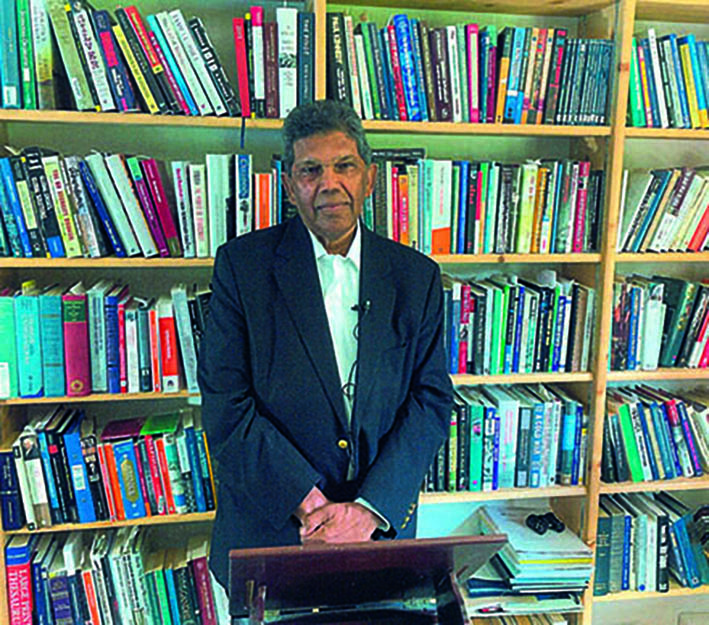Earlier this year, President Dr Mohamed Irfaan Ali published a policy brief in his book “Achieving Global Food Security. The Caribbean Experience and Beyond.” It deserves wide attention and should be the subject of a policy discussion throughout the CARICOM, and especially in Guyana – because of policy proposals and commitments by Guyana.
It is to be appreciated that President Ali has arranged for the publication of the book, which draws on the technical expertise of officials in Guyana and the CARICOM. The book is essentially a broad policy brief in the crucial area of food security, and it would be good to have similar policy briefs in key areas of governance, including one on nation-building in Guyana. One would also encourage the discussion of such policy briefs, including the present one, in Parliament.
One of the merits of the book is its inclusion of 57 pages of ‘Country Briefs’ on fourteen CARICOM countries, obviously drawing on specialists in the field within CARICOM. All together the book is 112 pages long, and has a useful bibliography. It is preceded by an Author’s Note, two messages by leaders of the Food and Agriculture Organization, and a Preface by a Professor of international relations and governance. The book is technically well-produced, attractive and user-friendly.
Chapter 1, is a short introduction of 2 pages. Chapter 2 (7 pages) discusses the global picture of food security, while chapter 3 (10 pages discusses the regional picture. Chapter 4 is the largest in the book, with 57 pages containing 14 CARICOM country briefs. Chapter 5 (20 pages) has some strategic policy recommendations, while chapter 6 (12 pages) discusses works in the pipeline and the way forward in Guyana.
The book opens with a page “About the Author”, which lists his impressive academic qualifications, including a doctorate from the University of the West Indies. In his ‘Author’s Note’, next, President Ali writes that “the Caribbean Community remains vulnerable to climate, economic, energy and food shocks, the latter of which is mainly on account of the region’s extreme dependence on extra-regional food imports. … The end product of the book is the compilation of pertinent policy recommendations to guide the region’s priority action in advancing food security as well as an adumbration of ongoing initiatives.”
Setting the subject-matter in perspective, the Director-General of the FAO notes in his Message that in Latin America and the Caribbean 56.5 million people suffered from hunger in 2021. The FAO Director for Latin America and the Caribbean writes in his Message that Latin America and the Caribbean register high levels of inequality as well as record the highest cost of a healthy diet.
President Ali writes in his Introduction that global hunger “might have been at its highest level in 2022. … Overall, more than 900,000 people globally are battling famine-like conditions.” In the Caribbean, he adds, “Food prices in the region have been on the increase due to a combination of several factors ranging from the increase in pests and plant-related diseases to a surge in climate-related events and inflation coupled with higher share levels of food imports.” There had also, he notes, been an overall decline in private sector investment in agriculture.
The Caribbean Community, the author continues, is home to almost 17 million people, out of whom around 4.1 million are moderately or severely food insecure. In the Caribbean, extreme weather events have negatively affected food production, prompting the need for more progressive policies and regulations. Around half of the region’s states, he adds, have cultivated only 50% of their land available for agriculture.
The book refers to the Saint Barnabas Accord between Barbados and Guyana under which “Guyana will supply Barbados with several agricultural products…while allocating a share of its land to Barbados for the purpose of farming and livestock rearing at a concessional rate. Other initiatives include supporting Barbados in becoming the centre of meat and fish processing products. On the receiving side, Guyana will be benefiting from the supply of black belly sheep from Barbados, among others. In both countries, food terminal facilities will also be established to facilitate export to other countries, while efforts will be made to establish an exchange programme to facilitate aquaculture training.”
The book does not mention whether Parliament has discussed, or given its assent to these plans, especially the allocation of Guyanese lands.
The book provides a range of recommendations with a view to reducing the region’s food importation bill by 25% by 2025. A 25% reduction in food import bills would be the equivalent of 6 billion US dollars. 2025 is around the corner.
The recommendations include:
The establishment of a regional agro-tech campus.
Transitioning small-scale agricultural systems into ‘more competitive and dynamic ones’.
3. ’The development of a CARICOM Cross-Border Agri-Food Investment Strategy to support production corridors’.
4. Creating an enabling policy environment via an agri-tourism policy and roadmap.
5. Improving agricultural productivity.
6. Promoting agri-tourism and its value chains through strategic investments and public partnerships.
7. Strengthening intra-regional collaboration at the muti-national level and between public and private sectors for more impactful multi-destination marketing strategies to promote the uniqueness of the Caribbean brand.
8. Investing in improved national rural infrastructure (physical and digital) and regional solutions.
9. Developing training, reskilling, and upskilling programmes to equip individuals with the skills required to operate in the agri-tourism industry.
Some of the policy recommendations are elaborated upon, while some are to be fleshed out in the future.
It would be interesting to see which of these policy recommendations are brought to tangible implementation in the future. President Ali deserves to be commended for setting out his vision for Caribbean food security. As the saying goes, the proof of the pudding will be in the eating.






